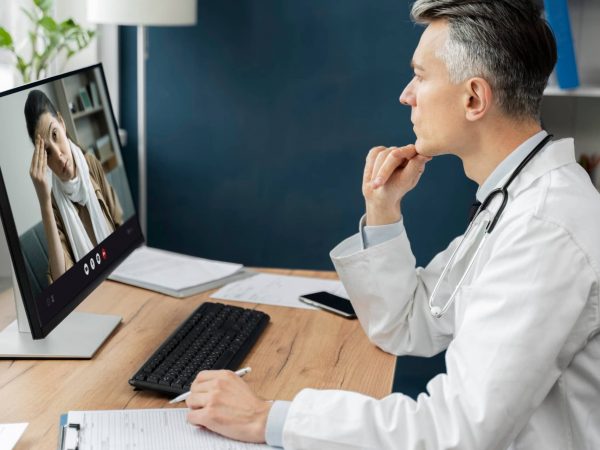
Today, almost half of all Americans suffer from at least one chronic disease. And that number is only expected to rise. We need new solutions to manage the growing patient population.
Monitoring a patient’s health is one of the best ways to improve their outcome. It allows care providers to identify health issues before they get out of hand. But it can prove challenging in modern healthcare spaces.
Having a patient attend regular check-ups can be difficult at the best of times. Chronic health conditions only make it harder to keep up with these routines.
That’s where remote medical monitoring can be a huge difference-maker. This healthcare technology makes it easier for people to receive the care they need. And it helps provide peace of mind for care providers.
Are you ready to make this technology part of your healthcare strategy? Learn more about how remote patient monitoring devices can help improve patient outcomes.
Remote medical monitoring is the use of medical devices to collect patient data. Unlike an in-person checkup, a care provider does not need to meet the patient to do this. Instead, smart technology monitors the patient and reports back to the care professional.
This healthcare innovation provides real-time insight into the patient’s health.
Remote medical monitoring has been essential in improving the quality of healthcare worldwide. It’s made care more accessible, practical, and affordable to millions of people.
If patients are not able to access a doctor in-person, they may benefit from remote monitoring as an alternative. They can stay connected with their doctor even if they are unable to travel to an office or hospital.
Success in healthcare means meeting patients where they are. Often literally, for those living in underserved regions. Remote medical monitoring makes that easier than ever before.
For example, healthcare has always been a challenge in rural and remote areas.
In the past, receiving care required patients to travel to a clinic or hospital. There, they might face long wait times and sizable out-of-pocket charges.
Lucky patients would have easy access to a care facility. But traveling to see a doctor can be unfeasible for patients with chronic conditions. And that’s to say nothing of the travel expenses these patients may incur.
Telehealth solutions allow patients to receive care in their own homes. Remote patient monitoring devices give care providers the insights needed to tend to the individual. This saves time and money while still allowing them access to care.
Remote medical monitoring is a boon to healthcare facilities, as well. By reducing the need for clinic visits, it helps reduce congestion in waiting rooms.
Routine check-ups, medication management, and minor illnesses can be handled via telehealth solutions. It’s often even possible to treat chronic diseases remotely. This frees up scarce resources at hospitals and clinics.
Healthcare professionals never want to have to make an emergency intervention. Unfortunately, that situation will arise sooner or later. When it does, acting with haste will help guarantee the best possible outcome for the patient.
Remote medical monitoring grants care professionals the ability to do exactly that. They can monitor a patient’s condition and intervene as soon as it becomes necessary.
Remote patient monitoring devices gather data on vital signs, medication adherence, and other relevant parameters. This data is securely transmitted to healthcare teams who can take appropriate action when needed.
Suppose a patient’s blood pressure or heart rate deviates from the normal range. Their care team will know right away and can act to prevent the situation from escalating.
This proactive approach doesn’t only improve patient outcomes. It can reduce the likelihood of emergency room visits and hospital admissions. This can help keep costs down for the patient and free up emergency care resources.
At the same time, remote medical monitoring helps patients take an active role in their healthcare management. They become participants in their treatment by sharing information with their care providers. This can make them more mindful of their well-being and less likely to ignore symptoms.
By becoming part of the process, patients can collaborate in care decisions. This promotes patient engagement and encourages individuals to take control of their health.
Medication adherence is an ongoing challenge in the healthcare sphere. Patients only take their medications as prescribed about half of the time. Millions of patients either forget to take their medication or fail to do so on time.
Non-adherence to prescribed medications can lead to worsening health conditions. In turn, this causes more hospitalizations and higher healthcare costs. Remote medical monitoring effectively addresses this issue by improving medication management.
Connected devices allow healthcare providers to check patients’ medication adherence. Patients receive reminders to take their medications, helping them stick to a schedule. This reduces the risk of medication errors and improves treatment outcomes.
It’s not enough for a healthcare plan to be effective. It also needs to be convenient and practical.
That’s why healthcare is problematic for many patients. Those with chronic conditions may struggle to keep up with their treatment. Patients in underserved areas may not be able to travel to seek care.
Remote medical monitoring is revolutionizing healthcare by addressing those issues. It makes treatment convenient, practical, and effective. Contact us today to learn more about how to make BlueStar’s patient monitoring solutions part of your care strategy.